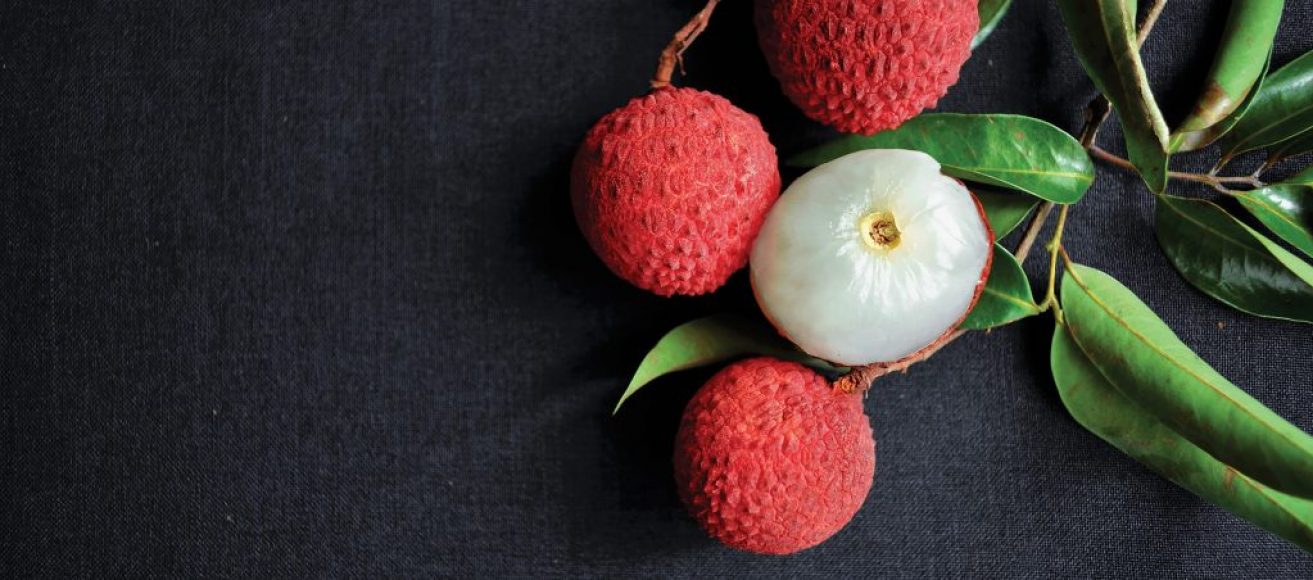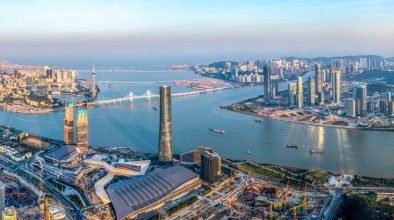Perhaps the most Chinese of the world’s exotic fruits, the lychee isn’t just full of flavour and nutrition – it’s also full of history.
Yang Yuhuan – or Yang Guifei, as she was also known – was the best-loved concubine of Emperor Xuan Zhong, whose reign of 43 years between 713 and 756AD was the longest of China’s Tang dynasty. Yang was one of the ‘Four Beauties of ancient China’ and is famous for her love for the Emperor. She is perhaps less known, however, for her love for the lychee, her favourite fruit. She adored it so much that the Emperor had couriers ride night and day to bring her the sweet treat from Guangdong, some 1,900 kilometres away from her home in the capital.
Today, however, lychee enthusiasts don’t need to go to such great lengths to obtain a punnet of their favourite fruit. Lychees are available in markets and supermarkets across the globe, from Tokyo to Toronto. The king of China’s exotic fruits remains as popular and adored as it was in Yang Yuhuan’s day – and it’s being consumed in greater quantities worldwide every year.
China is, of course, the world’s biggest producer of the fruit, accounting for more than 60 per cent of the global output. Guangdong ranks first in the country, with more than 266,667 hectares of lychee orchards scattered throughout the province. Last year, 1.5 million tonnes were produced in the province and its exports were estimated to be worth more than US$10 billion – or MOP81 million – with 80 per cent going to the United States, Canada and Europe.
Global production of the fruit has nearly doubled over the past 15 years – most of it in China. New and more sophisticated technology enables producers to store longer and ship over greater distances. The growers see many new markets to conquer – and that includes the producers in Guangdong, who are ambitious to say the least.
Lychees are delicious and juicy – and they are also low in calories and rich in fibre. A 100g serving of fresh lychees provides 86 per cent of the daily recommended vitamin C, hence their popularity worldwide. The fruit can be eaten fresh, dried or canned. And they are steeped in history.
Made in China
The lychee tree is believed to have originated more than 2,000 years ago in the northern mountain forests of southern China. Then, rivers and migratory birds carried the fruit to areas of Guangdong and Fujian provinces on the banks of rivers or close to the sea, where growing conditions were ideal. Some villages in South China have trees that are more than 1,000 years old.
China, therefore, became the first country to cultivate the fruit. In 111BC, during the Han Dynasty, the royal record described a trial of planting lychee trees in the palace on the order of Emperor Hanwu – but it ended in failure as the plants couldn’t survive the northern climate. However, down south, cultivation took root – and the Chinese love affair with producing lychees has never dampened over 2,000 years. In 1059AD, for instance, imperial documents during the Song Dynasty note 32 lychee cultivars in Fujian Province. In 1780, 43 cultivars are mentioned in Fujian, as well as Sichuan, Guangxi and, of course, Guangdong.
In 1760 and 1860, two lychee varieties were introduced from the Mainland to northern Taiwan. Large-scale production for commercial purposes began at the end of the 1920s in the south of the island, where the land and climate was more suitable. The trees there are sheltered by the central mountains from the strong winds of the Pacific Ocean.
In the 1800s, Chinese emigrants took the seeds with them to Southeast Asia, the West Indies, South Africa and Madagascar – and gold miners from the Middle Kingdom transported trees with them to Australia in the 1850s. Australia now has the longest lychee production season in the world, growing the fruit from late October to late March.
One interesting story of lychees spreading far and wide in the 19th century involves Reverend William Brewster, a missionary working in China. Between 1903 and 1906, he imported Royal Chen Purple lychee trees – named after the Chen family, a famous lychee growing family in Guangdong – from northern Fujian to south and central Florida, USA. They were the first lychee trees to be introduced to the country and they were a hit – the Brewster variety is still grown there and is hugely popular in America. Some of the trees have reached an enormous size and the sweet Brewster is now loved across the world.
Over the years, lychees have also been taken across Asia and the Middle East. It has become an important commercial crop in Thailand, for instance – and even Israel has become a prominent producer. In the 1870s, the trees arrived in South Africa and there has been a growth in their industry over the years, with production today at about 18,000 tonnes per annum, with most of the fruit being sold in Johannesburg but around 1,000 tonnes of that heading to Europe every year, where there is a large demand from countries like the UK and France. From its Chinese roots, over 2,000 years the lychee has become an international fruit.
Growth in the China market
In the first three decades of the PRC, lychee cultivation in Guangdong grew slowly. It was a planned economy. Farmers mainly grew it for their own consumption and to sell to local markets. Between 1949 and 1982, the average annual production was only 40,000 tonnes.
Agriculture in Guangdong has always been different to that in the rest of China. The Pearl River Delta (PRD) is the most famous region of the province but this fertile area accounts for only a fraction of Guangdong’s land area. Of this area, 80 per cent is hilly, with poor soil and vulnerable to erosion. The farmers of the PRD, however, have aimed not for subsistence agriculture but to exploit their comparative advantage, in fruit, sugar cane, fish farming and flowers – products that yield a higher profit than grain or cotton.
So, with the start of reform and open-door policies in the early 1980s, the farmers of Guangdong – like their brothers and sisters in industry and commerce – were quick to seize the new market opportunities. Since the 1980s, there have been dramatic improvements in production technologies in Guangdong. This was due to widespread reforms in rural areas and the introduction of a market economy. Under the reforms, farmers could choose what to grow on a certain portion of their land – and they found that growing lychee was more profitable than most other crops. At the same time, market demand increased strongly.
Before 1990, most orchards were managed by a family, with several trees or several hectares. But, since 1990, large corporations have invested in the fruit, creating orchards of up to several hundred hectares. This growth in demand has been possible only because of dramatic improvements in the road, rail and air infrastructures, enabling food products to be delivered rapidly to consumers in the cities. Lychee is best eaten fresh, so delivery time is critical. These large corporations have the capital and expertise to build cold storage and warehouses for the lychees so they don’t need to be delivered to market all at once.
More than half of all the lychees produced are consumed fresh, with about 30 per cent being used to make lychee nuts or dried lychees and a small portion of which are frozen, canned or fermented. Although different varieties vary considerably in the time of maturation, the peak period of harvest lasts for only about one and half months from late May to early July. Most of the fruit that is produced in this time has to be transported to market immediately after picking, with only a small portion that is then cold-stored.
For local markets, where transportation takes only a few hours, the fruit is not treated – it is usually packed in bamboo baskets or cardboard boxes. For long-distance markets, where transportation takes more than a dozen hours, the fruit is commonly packed in plastic bags and foam boxes with added ice.
Huang Xuming, professor of fruit physiology at the College of Horticulture at South China Agricultural University, Guangzhou, says that global production increased from 1.45 million tonnes in 2005 to 1.9 million in 2011. He adds that it’s now up to between 2.6 and 2.8 million. “The domestic market is the most important,” he says. “High labour costs, lack of cold chain facilities and low incentives for the growers have been the major non-technical constraints in the industry. Since 2005, the Chinese government has strongly supported research and development of the industry.”
“The government established the National Lychee and Longan Research System in 2008,” continues Huang, “with 16 researchers doing research. In six provinces, 12 experimental stations have been set up to provide field experiments, technology demonstrations and training for growers. This system is considered a very important contributor to the sustainable development of the industry.”
Top of the crops
One of the top exporters in China is Foshan Fuyi Food Company, established in the Gaoming district of the city in 2004. It preserves, processes, stores and exports fruits and vegetables. It is also one of Guangdong’s biggest exporters of lychee and longan – another tropical fruit related to the lychee – to the US, as well as selling to Canada, Britain, Australia, Holland and Italy. Its biggest external markets are Hong Kong and Macao – markets it can reach by road or boat down the Pearl River.
The firm has three large workshops for drying, clearing and packing and six cold storage units for finished products. It also has three special production lines to classify and preserve lychee and longan, with daily production of more than 60 tonnes. The company says that the government established a strict regimen to inspect lychee orchards that produce for export as well as inspection of packaging equipment in the factories.
Fu Yi chairman Chen Yaodong says that, even before a lychee tree is planted, customs officials come to the orchard that aims to export. “They inspect the ground and water quality,” he says, “to see if they are up to standard. Orchards and packaging plants that have not registered with the customs cannot export. The whole inspection procedure is strict.”
“After the lychees have passed domestic inspection,” continues Chen, “they must then be inspected by the importing country. The US, Japan and the European Union all have detailed inspection procedures. The US inspection items are many and their demands are very high.”
Eating lychees in Europe
While China remains the most important market for Guangdong’s lychee growers, foreign countries offer enormous potential. Lychees are growing in popularity in Europe but consumption is limited. The growers want to reach beyond the traditional market of overseas Chinese – especially Cantonese – who have carried their love of the lychee with them.
In a report published in February this year, the Confederation of British Industry says that, in Europe, the lychee is most popular in France, with Madagascar and South Africa supplying the majority of lychees during the winter season from October to February. “Supply during the summer season is much more limited,” it notes, “but offers opportunities for countries such as Vietnam, Thailand and Israel.”
The report places the import market in Europe at between 20,000 to 25,000 tonnes of the fruit a year. “Lychees do not ripen after harvesting,” it says. “Therefore, lychees should only be harvested when they are fully ripened. To prevent the fruit from deteriorating after picking, it can be fumigated with sulphur dioxide. This treatment makes sea transport possible, as long as the fruit is kept in cooled conditions. It will also change the colour of the fruit to yellow, while European buyers prefer its natural red colour.”
The lychee is indeed adored in China and across the world – and this love is clearly growing every year, with producers reaping the benefits. Madame Yang Gui-fei may be the most famous lover of the lychee – but many people, at home and abroad, share her passion and may also go to great lengths to indulge in their favourite fruit.
Lychees: the facts
- Lychee is a tropical plant, originating in China, that belongs to the soapberry family.
- There are three subspecies of lychee but only one is cultivated as a source of food, thus it’s commercially important.
- Cultivation of the lychee began 2,000 years ago. It grows on well-drained, slightly acidic soil and requires cold weather during the winter for the successful development of flower buds and warm, moist weather with high temperatures during the summer for the production of the fruit.
- Lychee is a medium-sized tree that can reach up to 50 feet in height. It blooms from November to February in the northern hemisphere and from April to August in the southern. The flowers are fragrant and attract bees, the main pollinators.
- It is a perennial plant and can survive for up to 1,000 years in the wild.
- The fruit’s skin is rough but its edible flesh is succulent, white and translucent. Each fruit contains one large, shiny, brown seed.
- Lychee is a rich source of dietary fibres, vitamins C, B1, B3, B9 and minerals such as copper and potassium. A 100g serving contains 66 calories.
- The seeds contain toxic compounds that can induce unpleasant side effects in the digestive system after consumption.
- Lychee is a natural diuretic which can alleviate pain associated with kidney stones and can reduce the formation of blood clots. It can also prevent the development of breast cancer.
- In Chinese traditional medicine culture, lychee is a ‘hot fruit’ which can warm up your kidneys and can help your reproduction system. Don’t have too many, though – it is not suitable for those with gout or diabetes.
- It is known across the world as the ‘Chinese strawberry’. In the Middle Kingdom, it is the symbol of love and romance.



